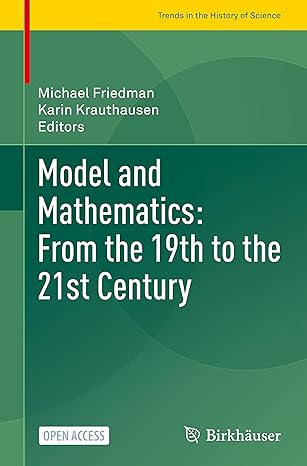
|
FreeComputerBooks.com
Links to Free Computer, Mathematics, Technical Books all over the World
|
|
- Title: Model and Mathematics: From the 19th to the 21st Century
- Author(s) Michael Friedman, Karin Krauthausen
- Publisher: Birkhäuser; 1st ed. (August 9, 2022); eBook (Creative Commons Licensed)
- License(s): Creative Commons License (CC)
- Hardcover/Paperback: 451 pages
- eBook: PDF and ePub
- Language: English
- ISBN-10/ASIN: 303097832X
- ISBN-13: 978-30309783270
- Share This:

|
This open access book collects the historical and medial perspectives of a systematic and epistemological analysis of the complicated, multifaceted relationship between model and mathematics, ranging from, for example, the physical mathematical models of the 19th century to the simulation and digital modelling of the 21st century.
The aim of this anthology is to showcase the status of the mathematical model between abstraction and realization, presentation and representation, what is modeled and what models.
About the Authors- N/A
- History of Mathematics
- Popular, Recreational, and Miscellaneous Mathematics
- Geometry and Topology
- Algebra, Abstract Algebra, and Linear Algebra
- Calculus and Mathematical Analysis
- Number Theory

- Model and Mathematics: From the 19th to the 21st Century (Michael Friedman, et al)
- The Mirror Site (1) - PDF
-
 Men of Mathematics: Great Mathematicians from Zeno to Poincaré
Men of Mathematics: Great Mathematicians from Zeno to Poincaré
This book provides a rich account of major mathematical milestones, from the geometry of the Greeks through Newton’s calculus, and on to the laws of probability, symbolic logic, and the fourth dimension.
-
 Making up Numbers: A History of Invention in Mathematics
Making up Numbers: A History of Invention in Mathematics
The book explains how conceptual hurdles in the development of numbers and number systems were overcome in the course of history, from Babylon to Classical Greece, from the Middle Ages to the Renaissance, and so to the nineteenth and twentieth centuries.
-
 How We Got from There to Here: A Story of Real Analysis
How We Got from There to Here: A Story of Real Analysis
This book is an introductory real analysis textbook, presented through the lens of history. The definitions and techniques are motivated by the actual difficulties encountered by the intuitive approach and are presented in their historical context.
-
 The Story of Euclid (W. B. Frankland)
The Story of Euclid (W. B. Frankland)
Euclid was a Greek mathematician, often referred to as the "Father of Geometry". His Elements is one of the most influential works in the history of mathematics, serving as the main textbook until the late 19th or early 20th century.
-
 Non-Euclidean Geometry: A Critical and Historical Study
Non-Euclidean Geometry: A Critical and Historical Study
This work has been selected by scholars as being culturally important, and is part of the knowledge base of civilization as we know it. This work was reproduced from the original artifact, and remains as true to the original work as possible.
-
 Mathematical Discovery (A.M. Bruckner, et al)
Mathematical Discovery (A.M. Bruckner, et al)
A course introducing the idea of mathematical discovery, especially to students who may not be particularly enthused about mathematics as yet, in which the students could actually participate in the discovery of mathematics.
-
 Topological Groups: Yesterday, Today, Tomorrow (Sidney A. Morris)
Topological Groups: Yesterday, Today, Tomorrow (Sidney A. Morris)
In 1900, David Hilbert asked whether each locally euclidean Topological Group admits a Lie group structure. This book should give the reader an overview of topological group theory as it developed over the last 115 years, as well as current research.
-
 Analytic Number Theory: A Tribute to Gauss and Dirichlet
Analytic Number Theory: A Tribute to Gauss and Dirichlet
The book begins with a definitive summary of the life and work of Dirichlet and continues with thirteen papers by leading experts on research topics of current interest in number theory that were directly influenced by Gauss and Dirichlet.
-
 Euclid and His Twentieth Century Rivals (Nathaniel Miller)
Euclid and His Twentieth Century Rivals (Nathaniel Miller)
Twentieth-century developments in logic and mathematics have led many people to view Euclid's proofs as inherently informal, especially due to the use of diagrams in proofs. It introduces a diagrammatic computer proof system, based on this formal system.





